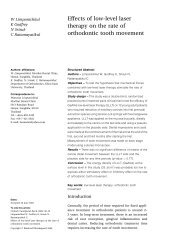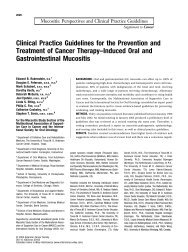Management of Mouth Opening in Patients with Temporomandibular ...
Management of Mouth Opening in Patients with Temporomandibular ...
Management of Mouth Opening in Patients with Temporomandibular ...
You also want an ePaper? Increase the reach of your titles
YUMPU automatically turns print PDFs into web optimized ePapers that Google loves.
48 Núñez et al.<br />
<strong>Mouth</strong> openig amplitude (mm)<br />
60<br />
50<br />
40<br />
30<br />
20<br />
10<br />
LILT first week followed by TENS<br />
TENS first week followed by LILT<br />
Initial 1 week F<strong>in</strong>al 1 week Initial 2 week F<strong>in</strong>al 2 week<br />
Timel<strong>in</strong>e<br />
FIG. 4. Mean values <strong>of</strong> the evolution <strong>of</strong> mouth open<strong>in</strong>g <strong>of</strong><br />
both groups dur<strong>in</strong>g experimental period.<br />
DISCUSSION<br />
In this study, the range <strong>of</strong> mandibular motion was evaluated<br />
<strong>in</strong> patients <strong>with</strong> TMD after LLLT or TENS to verify improvement<br />
<strong>in</strong> mouth open<strong>in</strong>g <strong>of</strong> those patients immediately after<br />
therapy. Both therapies were effective <strong>in</strong> improv<strong>in</strong>g the amplitude<br />
<strong>of</strong> mandibular movement. Compar<strong>in</strong>g the two methods,<br />
LLLT was more efficient than TENS.<br />
Even though pa<strong>in</strong> is almost certa<strong>in</strong>ly the most precise symptom<br />
that had been treated <strong>in</strong> this study, the evaluation <strong>of</strong> pa<strong>in</strong>,<br />
probably, would not be the most objective parameter to assess<br />
the purposed treatments. Kulekcioglu et al. 9 showed that after<br />
15 sessions <strong>of</strong> LLLT, TMD responded to therapy <strong>with</strong> a significant<br />
reduction <strong>in</strong> pa<strong>in</strong> presented either by the laser or by the<br />
placebo group, but only the active laser group presented improvements<br />
on mouth open<strong>in</strong>g, lateral motion, and number <strong>of</strong><br />
trigger po<strong>in</strong>ts. So, <strong>in</strong> this study the range <strong>of</strong> mandibular motion<br />
was chosen to evaluate the efficacy <strong>of</strong> the purposed treatments.<br />
The psychological component <strong>of</strong> TMD appears to be remarkably<br />
important. <strong>Patients</strong> <strong>with</strong> diagnoses <strong>of</strong> TMD are rendered<br />
susceptible to placebo effects <strong>of</strong> any treatment carried<br />
out. Indeed, placebo effect for an assortment <strong>of</strong> treatments for<br />
patients <strong>with</strong> TMD has been shown to be effective <strong>in</strong> more than<br />
40% <strong>of</strong> the cases. 2,19 In this study, a placebo control was not<br />
performed because, although it would be easily achieved <strong>in</strong> the<br />
laser treatment, it would not be performed <strong>in</strong> the TENS group<br />
<strong>with</strong> the same reliability because the patient would not feel<br />
anyth<strong>in</strong>g and also would not hear a sound for over 30 m<strong>in</strong>;<br />
thus, the placebo effect would be compromised by the TENS<br />
therapy. Further <strong>in</strong>vestigation <strong>with</strong> a larger sample to <strong>in</strong>vestigate<br />
placebo effects is warranted.<br />
TENS is conventionally used to relax muscles. TENS therapy<br />
is recommended, at a treatment dose <strong>of</strong> over 60 m<strong>in</strong>. 5 In<br />
order to provide a feasible cl<strong>in</strong>ical application, a period <strong>of</strong> 30<br />
m<strong>in</strong> was chosen. Even <strong>with</strong> this shorter period <strong>of</strong> application,<br />
TENS therapy was effective <strong>in</strong> improv<strong>in</strong>g the amplitude <strong>of</strong><br />
mouth open<strong>in</strong>g <strong>in</strong> a significant manner, although a longer application<br />
period could promote even better results.<br />
On the other hand, LLLT has been used to treat a variety <strong>of</strong><br />
pathological conditions, <strong>in</strong>clud<strong>in</strong>g musculoskeletal pa<strong>in</strong>, posttraumatic<br />
jo<strong>in</strong>t disorder, and rheumatoid arthritis. 13 Although<br />
LLLT has been studied s<strong>in</strong>ce the early 1960s, it is not established<br />
as a cl<strong>in</strong>ical tool yet. 11 The multitude <strong>of</strong> parameters <strong>in</strong>volved<br />
<strong>in</strong> this therapy is probably delay<strong>in</strong>g its acceptance <strong>in</strong><br />
the cl<strong>in</strong>ical realm. 12<br />
Several reports have documented the beneficial effects <strong>of</strong><br />
LLLT on the management <strong>of</strong> patients <strong>with</strong> TMD. 9–11,20 Gur et<br />
al., 21 <strong>in</strong> a randomized controlled, double-bl<strong>in</strong>d cl<strong>in</strong>ical trial<br />
<strong>with</strong> 60 patients, used the 904-nm laser to treat chronic my<strong>of</strong>ascial<br />
pa<strong>in</strong>. The overall result after 2 weeks <strong>of</strong> treatment<br />
showed that LLLT was effective <strong>in</strong> pa<strong>in</strong> relief and <strong>in</strong> the improvement<br />
<strong>of</strong> the functional ability <strong>of</strong> the patients. The energy<br />
applied over each site was 3 J. Energies <strong>of</strong> 6–12 J seem to be<br />
effective <strong>in</strong> promot<strong>in</strong>g muscular relaxation. 20<br />
The wavelength used <strong>in</strong> this work is not considered the most<br />
appropriate one to promote analgesic effects due to its penetration<br />
depth. 22 The radiation penetration depth is a controversial<br />
issue, and more objective data about tissue optics are necessary.<br />
11 The forward scatter<strong>in</strong>g <strong>of</strong> the radiation would promote<br />
the penetration <strong>of</strong> the radiation <strong>in</strong>to deeper tissues. LLLT’s<br />
most commonly used wavelengths (630–1300 nm) present a<br />
predom<strong>in</strong>ant forward-directed scatter<strong>in</strong>g. 23 Furthermore, due<br />
to the optical characteristic <strong>of</strong> this therapy, the patient’s <strong>in</strong>dividual<br />
characteristics should also be taken <strong>in</strong>to account, s<strong>in</strong>ce<br />
the right energy does not only have to be applied on the surface,<br />
but also must reach the target area.<br />
Both treatments tested <strong>in</strong> this trial presented good results.<br />
LLLT was more efficient than TENS therapy. LLLT is more<br />
comfortable to the patient because it does not cause any sensation<br />
dur<strong>in</strong>g its application. TENS therapy promotes a sensation<br />
like a m<strong>in</strong>or electrical shock, which is comfortable for some<br />
patients while to others is a strange sensation. Thus the patient<br />
compliance <strong>with</strong> the therapy may be an important factor.<br />
The results showed no cumulative beneficial effects because<br />
from the end <strong>of</strong> the first treatment session to the end <strong>of</strong> the second<br />
treatment session no improvements were detected. This<br />
data re<strong>in</strong>force the probability <strong>of</strong> an immediately analgesic effect.<br />
In patients <strong>with</strong> TMD, to observe long-last<strong>in</strong>g improvements,<br />
a prolonged treatment may be necessary. In a cl<strong>in</strong>ical<br />
trial, Conti 24 reported that, after three treatment sessions, LLLT<br />
<strong>with</strong> 830-nm laser and energy <strong>of</strong> 4 J did not show a significant<br />
effect. Although some cl<strong>in</strong>ical f<strong>in</strong>d<strong>in</strong>gs were positive, the statistical<br />
analyses did not show differences between laser and<br />
placebo groups. Conti suggested that <strong>in</strong>creased frequency <strong>of</strong><br />
laser application may improve the results. 24<br />
Randomized, placebo-controlled cl<strong>in</strong>ical trials <strong>with</strong> a significant<br />
sample must be performed <strong>in</strong> order to validate this therapy.<br />
The results obta<strong>in</strong>ed <strong>in</strong> this study <strong>in</strong>dicate that LLLT could<br />
be an adjuvant <strong>in</strong> the management <strong>of</strong> patients <strong>with</strong> TMD.<br />
CONCLUSION<br />
In this study, the range <strong>of</strong> mandibular motion was evaluated<br />
<strong>in</strong> patients <strong>with</strong> TMD after LLLT or TENS to verify improvement<br />
<strong>in</strong> mouth open<strong>in</strong>g immediately after therapy. Both<br />
therapies were effective <strong>in</strong> improv<strong>in</strong>g the amplitude <strong>of</strong> mandibular<br />
movement. These treatments should be performed before<br />
conventional dental treatment <strong>in</strong> patients <strong>with</strong> TMD.<br />
Compar<strong>in</strong>g the two methods, LLLT was more effective than<br />
TENS therapy.











